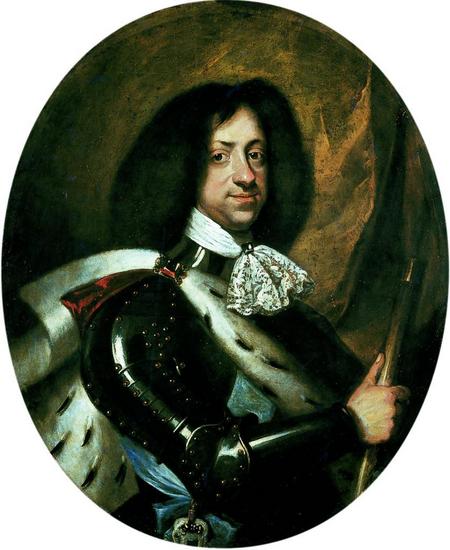Death of Christian V of Denmark
Christian V died in Copenhagen on August 25th, 1699, following a riding accident.
 The grand square in Copenhagen called Kongens Nytorv (New Royal Market), the largest in the city, is lined by splendid buildings and was originally created in 1680 by King Christian V, who is commemorated in the garden at the centre by a vigorous equestrian statue dating from later in the 1680s by a French sculptor, Abraham-César Lamoureux. The king is depicted in the costume of a Roman emperor, and the lead statue is so heavy that the weight of it eventually exhausted the horse, which had to be replaced in 1946. Around the base are Classical figures representing the royal virtues: Minerva for wisdom, Alexander the Great for courage, Hercules for strength and Artemis for honour.
The grand square in Copenhagen called Kongens Nytorv (New Royal Market), the largest in the city, is lined by splendid buildings and was originally created in 1680 by King Christian V, who is commemorated in the garden at the centre by a vigorous equestrian statue dating from later in the 1680s by a French sculptor, Abraham-César Lamoureux. The king is depicted in the costume of a Roman emperor, and the lead statue is so heavy that the weight of it eventually exhausted the horse, which had to be replaced in 1946. Around the base are Classical figures representing the royal virtues: Minerva for wisdom, Alexander the Great for courage, Hercules for strength and Artemis for honour.
This frankly boastful monument commemorates a ruler who fastened the monarchy’s grip firmly on Denmark, which at this time also ruled Norway. There had been a long struggle for power between the kings of the House of Oldenburg and the old, entrenched native Danish aristocracy. Royal absolutism suited the rich merchants of Copenhagen, who looked to a vigorous monarchy to protect their profitable Baltic trade.
Christian’s father, Frederick III, had made capital out of Denmark’s defeat by the Swedes under the formidable Swedish soldier-king Charles X. Though Charles failed to take Copenhagen by storm in 1659 thanks to the doughty resistance of the capital’s citizens, he won the war and Denmark lost the Scanian provinces in southern Sweden. Control of both sides of the Oresund, the narrow sound between Copenhagen and Scania, had previously put the entrance to the Baltic in Danish hands. The Danes blamed their defeat on blundering aristocrats and Frederick exploited the mood to organise an efficient centralised bureaucracy with himself as absolute monarch. In 1661 the fifteen-year-old Prince Christian went to Oslo to accept the allegiance of the Norwegians, who welcomed the new system because it would put them on a more equal footing with the Danes.
Succeeding his father in 1670, when he was twenty-three, Christian V continued Frederick’s policies and appointed Danish commoners and outsiders from Germany to the high offices of state instead of the great landowners. He also became the first Danish king to have an ‘official’ mistress. In 1675 he plunged into a renewed war against Sweden to recover Scania. The Danish fleet under its redoubtable admiral Niels Juel sank most of the Swedish navy, and the young Danish king led his invading army across the Oresund in person to take almost all of Scania, but then the tide turned against him and the war exhausted Denmark’s resources to no purpose. Christian is said to have had the windows of Kronborg Castle at Elsinore (where Shakespeare set Hamlet), looking a mere three miles across the Sound to Scania, blocked up because he could not bear to see the lost territory just over the water.
Brave, genial and conscientious, the monarch remained a popular figure until his death in Copenhagen at the age of fifty-three, which followed a riding accident. His German widow, Charlotte Amalie of Hesse-Kassel, moved into the Charlottenborg palace, which gave her a good view of her late husband’s statue. He bequeathed to their twenty-eight-year-old son, Frederick IV, the duty to regain Scania, but in vain. Denmark was never to recover the lost provinces, though to this day their inhabitants speak Swedish with a heavy Danish accent.




